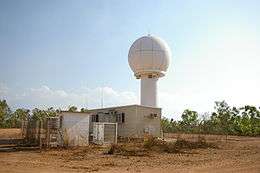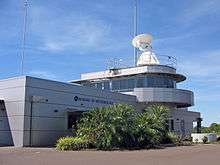Bureau of Meteorology
The Bureau of Meteorology (BOM) is an Executive Agency of the Australian Government responsible for providing weather services to Australia and surrounding areas. It was established in 1906 under the Meteorology Act, and brought together the state meteorological services that existed before then.[1] The states officially transferred their weather recording responsibilities to the Bureau of Meteorology on 1 January 1908.[2][3]
 | |
| Agency overview | |
|---|---|
| Formed | 1 January 1908 |
| Jurisdiction | Government of Australia |
| Headquarters | Melbourne |
| Employees | 1,663 (at 31 May 2015) |
| Annual budget | A$279.3 million (2015–16) |
| Minister responsible |
|
| Agency executive |
|
| Parent agency | Department of the Environment and Energy |
| Website | www.bom.gov.au |
Services and structure

The Bureau of Meteorology is the main provider of weather forecasts, warnings and observations to the Australian public. The Bureau distributes weather images via radiofax and is responsible for issuing flood alerts in Australia.
The Bureau's head office is in Melbourne Docklands, which includes the Bureau's Research Centre, the Bureau National Operations Centre, the National Climate Centre, the Victorian Regional Forecasting Centre as well as the Hydrology and Satellite sections.[4]
Regional offices are located in each state and territory capital. Each regional office includes a Regional Forecasting Centre and a Flood Warning Centre, and the Perth, Darwin and Brisbane offices also house Tropical Cyclone Warning Centres. The Adelaide office incorporates the National Tidal Centre, while the Darwin office the Volcanic Ash Advisory Centre and Regional Specialised Meteorological Centre (Analysis).

The Australian Bureau of Meteorology issues Tropical Cyclone Advices[5] and developed the Standard Emergency Warning Signal used for warnings. The Bureau is responsible for tropical cyclone naming for storms in waters surrounding Australia. Three lists of names used to be maintained, one for each of the western, northern and eastern Australian regions.[6] However, as of the start of the 2008–09 Tropical Cyclone Year these lists have been rolled into one main national list of tropical cyclone names.[6]
The regional offices are supported by the Bureau National Operations Centre (BNOC) which is also located at the head office in Melbourne Docklands.
The Bureau maintains a network of field offices across the continent, on neighbouring islands and in Antarctica. There is also a network of some 500 paid co-operative observers and approximately 6,000 voluntary rainfall observers.
Directors
The following people have been directors of the Bureau of Meteorology:
| Director | Term |
|---|---|
| Henry Ambrose Hunt | 1908–31 |
| William S Watt | 1931–40 |
| H. Norman Warren | 1940–50 |
| Edward W Timcke | 1950–55 |
| Leonard J Dwyer | 1955–62 |
| William J Gibbs | 1962–78 |
| John Zillman | 1978–2003 |
| Geoff Love | 2003–08 |
| Neville Smith (Acting Director) | 2008–09 |
| Greg Ayers | 2009–12[7] |
| Rob Vertessy | 2012–16[8] |
| Andrew Johnson | 6 September 2016–Present[9] |
Technology
In the head office a Cray XC40 supercomputer called "Australis" provides the operational computing capability for weather, climate, ocean and wave numerical prediction and simulation, while other Unix servers support the computer message switching system and real-time data base. The Australian Integrated Forecast System affords the main computing infrastructure in the regional offices. Numerical weather prediction is performed using the Unified Model software. The Bureau of Meteorology announced the Cray contract[10] in July 2015, commissioned the Cray XC40 supercomputer[11] on 30 June 2016 and decommissioned their Oracle HPC system in October 2016.
See also
- World Meteorological Organization, co-ordination body for weather, climate and environment services
- International Cloud Experiment, which collected data on tropical cyclones in January and February 2006
- 2019–20 Australian region cyclone season
- Water Data Transfer Format
- Australasian Fire and Emergency Service Authorities Council
References
- "Meteorology in the 20th Century". Federation and Meteorology. University of Melbourne: Australian Science and Technology Heritage Centre. August 2001. p. 1600. Retrieved 28 March 2019.
- "BOM celebrates 100 years". Australian Broadcasting Corporation. Retrieved 1 January 2008.
- "Collections in Perth: 20. Meteorology". National Archives of Australia. Archived from the original on 12 February 2012. Retrieved 24 May 2008.
- "Bureau of Meteorology Head Office 700 Collins Street". Bureau of Meteorology. Retrieved 24 May 2008.
- Tropical Cyclone Advices, Bureau of Meteorology, 2009
- "Tropical Cyclone Names". Bureau of Meteorology. Retrieved 8 August 2008.
- "Government thanks outgoing Bureau of Meteorology director, Dr Greg Ayers". Department of Sustainability, Environment, Water, Population and Communities. 20 February 2012. Archived from the original on 27 February 2012. Retrieved 23 February 2012.
- "'Perilous': Bureau of Meteorology boss Rob Vertessy exits with climate warning". The Sydney Morning Herald. 30 April 2016. Retrieved 30 May 2016.
- "Dr Andrew Johnson appointed as Director of Meteorology". Bureau of Meteorology. 5 September 2016. Retrieved 22 September 2016.
- "New Supercomputer to supercharge weather warnings and forecasts". Bureau of Meteorology. 21 July 2015. Retrieved 2 September 2017.
- "New Bureau supercomputer successfully commissioned". Bureau of Meteorology. 19 November 2016. Retrieved 2 September 2017.
External links
| Wikimedia Commons has media related to Bureau of Meteorology. |